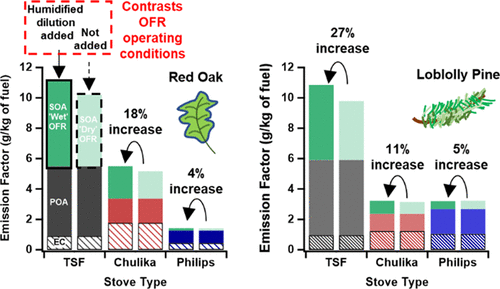当前位置:
X-MOL 学术
›
ACS Earth Space Chem.
›
论文详情
Our official English website, www.x-mol.net, welcomes your
feedback! (Note: you will need to create a separate account there.)
Influence of Stove, Fuel, and Oxidation Flow Reactor Conditions on Aging of Laboratory-Generated Cookstove Emissions
ACS Earth and Space Chemistry ( IF 2.9 ) Pub Date : 2021-06-04 , DOI: 10.1021/acsearthspacechem.1c00081 Aditya Sinha 1 , Mohammad Maksimul Islam 1 , Andrew Grieshop 1
ACS Earth and Space Chemistry ( IF 2.9 ) Pub Date : 2021-06-04 , DOI: 10.1021/acsearthspacechem.1c00081 Aditya Sinha 1 , Mohammad Maksimul Islam 1 , Andrew Grieshop 1
Affiliation

|
Oxidation flow reactor (OFR) experiments are a useful way to explore secondary organic aerosol (SOA) production during photochemical aging of biomass combustion emissions. Here, we extend previous work by studying SOA formed by emissions from three cookstoves used in low-income settings (Philips, Chulika, and three-stone fire (TSF)) while varying the fuel type (red Oak and loblolly Pine) and OFR operating conditions. Differences in SOA formation across fuel types were relatively minor, with SOA formation increases of <30% for Oak vs Pine experiments. Mass spectral fragments (f44, f43, and f60) from aged Oak and Pine emissions generally spanned the same continuum with combustion technology playing a larger role in dictating aged OA evolution than the fuel type. Combustion technology also has a much greater influence on net aerosol climate forcing relative to interfuel differences. The OFR was operated under “wet” and “dry” conditions, to study the impacts of more or less tropospherically relevant oxidation conditions on SOA formation, respectively. SOA formation did not vary dramatically across OFR conditions and was larger by up to 27% for the TSF and 5% for the Philips for “wet” operation. OA spectral differences were greater, with f44 up to 28% greater for “wet” operating conditions at similar levels of aging. Overall, changes in reactor operation were not sufficient to alter major conclusions from previous work where the OFR was operated under conditions similar to the “dry” conditions applied here. Positive matrix factorization analyses on SOA spectra identified two factors, a transient oxidation factor and a uniformly aged factor, which were similar across experiments.
中文翻译:

炉子、燃料和氧化流动反应器条件对实验室产生的炉灶排放物老化的影响
氧化流动反应器 (OFR) 实验是探索生物质燃烧排放光化学老化过程中二次有机气溶胶 (SOA) 产生的有用方法。在这里,我们通过研究低收入环境中使用的三个炉灶(飞利浦、Chulika 和三石炉 (TSF))的排放物形成的 SOA,同时改变燃料类型(红橡木和火炬松)和 OFR 操作,从而扩展了先前的工作使适应。不同燃料类型的 SOA 形成差异相对较小,橡木与松木实验的 SOA 形成增加 <30%。质谱碎片(f 44、f 43和f 60) 来自老化橡树和松树的排放通常跨越相同的连续体,燃烧技术在决定老化 OA 演变方面比燃料类型发挥更大的作用。相对于燃料间的差异,燃烧技术对净气溶胶气候强迫也有更大的影响。OFR 在“湿”和“干”条件下运行,分别研究或多或少与对流层相关的氧化条件对 SOA 形成的影响。SOA 的形成在 OFR 条件下没有显着变化,TSF 的 SOA 形成高达 27%,而飞利浦的“湿”操作则高达 5%。OA 光谱差异更大,f 44在类似老化水平的“潮湿”操作条件下,最多可增加 28%。总体而言,反应堆运行的变化不足以改变先前工作的主要结论,其中 OFR 在类似于此处应用的“干燥”条件的条件下运行。SOA 光谱的正矩阵分解分析确定了两个因素,瞬态氧化因素和均匀老化因素,它们在实验中是相似的。
更新日期:2021-06-17
中文翻译:

炉子、燃料和氧化流动反应器条件对实验室产生的炉灶排放物老化的影响
氧化流动反应器 (OFR) 实验是探索生物质燃烧排放光化学老化过程中二次有机气溶胶 (SOA) 产生的有用方法。在这里,我们通过研究低收入环境中使用的三个炉灶(飞利浦、Chulika 和三石炉 (TSF))的排放物形成的 SOA,同时改变燃料类型(红橡木和火炬松)和 OFR 操作,从而扩展了先前的工作使适应。不同燃料类型的 SOA 形成差异相对较小,橡木与松木实验的 SOA 形成增加 <30%。质谱碎片(f 44、f 43和f 60) 来自老化橡树和松树的排放通常跨越相同的连续体,燃烧技术在决定老化 OA 演变方面比燃料类型发挥更大的作用。相对于燃料间的差异,燃烧技术对净气溶胶气候强迫也有更大的影响。OFR 在“湿”和“干”条件下运行,分别研究或多或少与对流层相关的氧化条件对 SOA 形成的影响。SOA 的形成在 OFR 条件下没有显着变化,TSF 的 SOA 形成高达 27%,而飞利浦的“湿”操作则高达 5%。OA 光谱差异更大,f 44在类似老化水平的“潮湿”操作条件下,最多可增加 28%。总体而言,反应堆运行的变化不足以改变先前工作的主要结论,其中 OFR 在类似于此处应用的“干燥”条件的条件下运行。SOA 光谱的正矩阵分解分析确定了两个因素,瞬态氧化因素和均匀老化因素,它们在实验中是相似的。











































 京公网安备 11010802027423号
京公网安备 11010802027423号